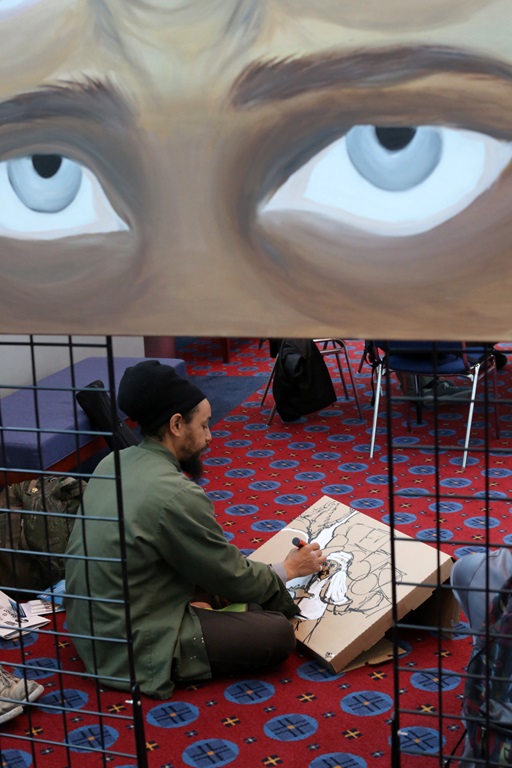Experiencing diversity
The elderly man studied the five words emblazoned in red on a white canvas. "God is in the graffiti." The message, though simple, perplexed him.
"How come God is in the graffiti? Isn't graffiti something bad?" the man asked, directing his question to the Rev. VJ Cruz-Baez, pastor at La Plaza United Methodist Church in Los Angeles.
The man was part of the audience at a gathering organized by Cruz-Baez. Community leaders, local residents and artists on this particular afternoon were discussing the intersection of religion, poverty, race and gender equality. As the conversation unfolded, the painters interpreted what they were hearing, adding paint to the canvas, using familiar styles often associated with graffiti and tagging.
{full_page_ad}
"God is in the graffiti" is an initiative created by Cruz-Baez that invites young street artists to create works that address issues affecting both local communities and the world. The project received funding through a grant from the General Commission on Religion and Race.
In response to the man who doubted God's presence in graffiti, Cruz-Baez said, "The Spirit is going to places where we think there is no God, because we think the place is too dark. Even those places where we think God can't be, God is there."
Graffiti, people transformed
The Rev. Joel Hortiales, associate director of Hispanic/Latino Ministries for the California-Pacific Conference, said finding value in what might be considered disrespectful or wayward extends beyond the art.
"With ‘God is in the graffiti,' something that is seen as bad is transformed or used by God to bring good," Hortiales said. "Not just the graffiti, which is connoted with bad ideas and tagging and doing bad, but also the kids who do that. The kids have value for us, the church, for the world. Those people are transformed and used by God."
Since "God is in the graffiti" first received funding in 2014, Cruz-Baez has seen the initiative's impact on the youth and young adult artists who have participated in the program.
"These young artists, some of them leave tagging and doing graffiti in illegal ways and now they are using ‘God is in the graffiti' to build their lives. They are using (their artwork) to build their voice," said Cruz-Baez.
Although "God is in the graffiti" began as an outreach at La Plaza Church, the program has extended beyond the local church and community. In 2016, the artists were invited to attend General Conference in Portland, Oregon, to paint canvases in response to discussions that were occurring during the quadrennial legislative assembly.
In 2016, Cruz-Baez and the artists also participated in the United Methodist Women's Leadership Development Days in St. Louis, Missouri; Tempe, Arizona; and Charlotte, North Carolina, where they created art in response to conversations about social and environmental justice topics.
"Young people and young adults have a voice, and they want to be part of the conversation if we invite them to use ways they are familiar with," said Cruz-Baez. "In doing so, we become ‘we' and work together for the community."
Expressing, experiencing God's love
Some of the art has been curated into a traveling exhibit that has been displayed in a number of Los Angeles area United Methodist churches and also displayed at arts festivals.
In addition to inviting young artists to express their spirituality in a unique way, Cruz-Baez said the paintings also may help those who view the art experience God's love.
"The project is a way to invite other people who don't respond to the traditional ways we present the message of God and present Jesus' love and grace and power and mercy," she said. "Through the project, we invite these people to see that there is a different way to see the gospel. I know we have an impact of love on people," Cruz-Baez said.
The initial grant has ended, but Cruz-Baez and Hortiales hope the initiative can continue. Bringing in more painters, hiring an artistic director, expanding the ministry to other churches and organizing a silent auction are among future goals, they said.
The ministry is an important outreach not only to young street artists, but also to the community, said Cruz-Baez.
"We need to go out and encounter the people where they are," she said.
"'God is in the graffiti' is an example of how to bring the church outside the walls," said Hortiales. "The ones who really walk with us are more open to seeing different possibilities to share the message of the Christ. They are transformed."
Crystal Caviness is a public relations specialist at United Methodist Communications in Nashville, Tennessee.

